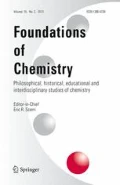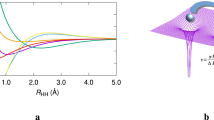Abstract
Heisenberg’s explanation of how two coupled oscillators exchange energy represented a dramatic success for his new matrix mechanics. As matrix mechanics transmuted into wave mechanics, resulting in what Heisenberg himself described as “…an extraordinary broadening and enrichment of the formalism of the quantum theory”, the term resonance also experienced a corresponding evolution. Heitler and London’s seminal application of wave mechanics to explain the quantum origins of the covalent bond, combined with Pauling’s characterization of the effect, introduced resonance into the chemical lexicon. As the Valence Bond approach gave way to a soon-to-be dominant Molecular Orbital method, our understanding of the term resonance, as it might apply to our understanding the chemical bond, has also changed.
Similar content being viewed by others
References
Bell, J.S.: On the Einstein Podolsky Rosen paradox. Physics 1, 195–200 (1964)
Bloch, F.: Heisenberg and the early days of quantum mechanics. Phys. Today 29, 23–27 (1976)
Bohr, N.: Can quantum-mechanical description of physical reality be considered complete? Phys. Rev. 48, 696–702 (1935)
Brush, S.G.: Dynamics of theory change in chemistry: part 2. Benxene and molecular orbitals, 1945–1980. Stud Hist Phil Sci 30, 263–302 (1999)
Dewar, M.J.S., Longuet-Higgins, H.C.: The correspondance between the resonance and molecular orbital theories. Proc Roy Soc 214, 482–493 (1952)
Dirac, P.: The physical interpretation of the quantum dynamics. Proc. Roy. Soc. Lond. A113, 621–641 (1927)
Einstein, A., Podolsky, B., Rosen, N.: Can quantum-mechanical description of physical reality be considered complete? Phys. Rev. 47, 777–780 (1935)
Frankland, E.: Contributions to the notation of organic and inorganic compounds. J. Chem. Soc. 19, 372–395 (1866)
Gavroglu, K.: Fritz London: A Scientific Biography, p. 85. Cambridge University Press, Cambridge (1995)
Healy, E.F.: In defense of a heuristic interpretation of quantum mechanics. J. Chem. Educ. 87, 559–563 (2010)
Heisenberg, W.: Multi-body problem and resonance in the quantum mechanics. Zeitschrift für Physik 38, 411–426 (1926)
Heitler, W., London, F.: Interaction between neutral atoms and homopolar bonding. Zeitschrift für Physik 44, 455 (1927) English translation in Hettema, H. “Quantum Chemistry, Classic Scientific Papers”, World Scientific, Singapore (2000)
Huckel, E.: Quantum-theoretical contributions to the benzene problem. I. The electron configuration of benzene and related compounds. Zeitschrift für Physik 70, 204–286 (1931)
Hund, F.: Zur Frage der chemischen Bindung. Zeitschrift für Physik 73, 1–30 (1931)
Jordan, P.: Uber eine neue Begr¨undung der Quantenmechamik I. Zeitschrift für Physik 40, 809 (1926)
Kerber, R.C.: If it’s resonance, what is resonating? J. Chem. Educ. 83, 223–227 (2006)
Lennard-Jones, J.E.: The electronic structure of some diatomic molecules. Trans. Faraday Soc. 25, 668–686 (1929)
London, F.: On the quantum theory of homo-polar valence numbers. Zeitschrift für Physik 46 , 455 (1928) English translation in Hettema, H. “Quantum Chemistry, Classic Scientific Papers”, World Scientific, Singapore (2000)
Malrieu, J.-P., Guihery, N., Calzado, C.J., Angeli, C.: Bond electron pair: its relevance and analysis from the quantum chemistry point of view. J. Comput. Chem. 28, 35–50 (2007)
Mulliken, R.S.: The assignment of quantum numbers for electrons in molecule. Phys. Rev. 32, 186–228 (1928)
Mulliken, R.S.: Selected Papers, ed. D.A. Ramsay, J. Hinze (University of Chicago Press), p. 8 (1975)
Pauling, L.: Shared-electron chemical bond. Proc. Natl. Acad. Sci. 14, 359–362 (1928)
Pauling, L.: The theory of resonance in chemistry. Proc. R. Soc. Lond. A. 356, 433–441 (1977)
Pauling, L.: The nature of the chemical bond–1992. J. Chem. Educ. 69, 519–521 (1992)
Ruedenberg, K.: The physical nature of the chemical bond. Rev. Mod. Phys. 34, 326–376 (1962)
Schrödinger, E.: An undulatory theory of the mechanics of atoms and molecules. Phys. Rev. 28, 1049–1070 (1926)
Schrödinger, E.: The present situation in quantum mechanics. Naturwissenschaften, 23, 807–812; 823–828; 844–849 (1935) English translation “Quantum Theory and Measurement”, eds. Wheeler, J.A., Zurek, W.H., Princeton Univ. Press (Princeton, NJ, 1983)
Shaik, S.: Is my chemical universe localized or delocalized? Is there a future for chemical concepts? New J. Chem. 31, 2015–2028 (2007)
Slater, J.C.: The theory of complex spectra. Phys. Rev. 34, 1293–1312 (1929)
Wheland, G.W., Pauling, L.: A quantum mechanical discussion of orientation of substituents in aromatic molecules. J. Am. Chem. Soc. 57, 2086–2095 (1935)
Wheland, G.W.: Resonance in Organic Chemistry, pp. 7, 75. Wiley, New York (1955)
Vermulapalli, G.K.: Theories of the chemical bond and its true nature. Found. Chem. 10, 167–176 (2008)
Acknowledgments
The author is grateful to the Educational Advancement Foundation (EAF) and the W. M. Keck Foundation grant for their generous support, and also the Welch Foundation (Grant # BH-0018) for its continuing support of the Chemistry Department at St. Edward’s University. The author also wishes to acknowledge the contributions of Brian Healy, whose commitment to the intellectual process served as a catalyst for this formulation.
Author information
Authors and Affiliations
Corresponding author
Appendix
Appendix
To derive a suitable formulation for (2) one multiplies the matrices from the Dirac-Jordan formulation into Ψ to give (A1). Reformulating as (A2) and recognizing that this is an expansion of the product rule for derivatives, one obtains equation (A3):
Thus, since the matrices of matrix mechanics are equivalent to the operators of wave mechanics, the form of the momentum operator \( \bar{p} \) must be \( - \hbar i\cdot{\frac{\partial }{\partial x}} \). Substituting for \( \bar{p} \) in (3) gives:
Rearrangement of (A4) gives \( - {\frac{{\hbar^{2} }}{2}}\left( {\frac{1}{m}{\frac{{\partial^{2} }}{{\partial x^{2} }}}} \right)\Uppsi + \overline{V} \Uppsi = E\Uppsi \), which is usually represented in the iconic formulation HΨ = EΨ. The exact form of Ψ is dictated by the requirement that the double derivative of Ψ has to yield the function times a negative constant. Thus Ψ can only be described as the sine function, the cosine function, or some combination of the two. Though the wave function of choice is the combination: \( \Uppsi = \exp (ikx) = \cos (kx) + i\cdot \sin (\cos (kx) \), it should be noted that \( \Uppsi = \sin (kx) \) is valid representation of a free, i.e. unbound, particle system. Now with \( {\frac{{\partial^{2} }}{{\partial x^{2} }}}\Uppsi = {\frac{{\partial^{2} }}{{\partial x^{2} }}}\exp (ikx) \) we get \( {\frac{{\partial^{2} }}{{\partial x^{2} }}}\Uppsi = - k^{2} \Uppsi = {\frac{{ - p^{2} }}{{\hbar^{2} }}}\Uppsi \), where k must be equal to \( {\frac{p}{\hbar }} \).
To demonstrate the equivalence of the Dirac-Jordan representation with Heisenberg’s original uncertainty formulation, consider a wave centered at position x 0. For any observed property the Gaussian function, \( e^{{{\frac{{ - (n - n_{0} )^{2} }}{{2\Updelta n^{2} }}}}} \), represents the distribution of measurements around a mean value n 0, where Δn represents the spread due to the uncertainty in measurement. It can easily be shown this type of statistical distribution represents not just a good choice, but actually the optimum choice, in terms of minimizing uncertainty. For a given value of k, i.e. k 0, the wave function for position can be described as an integral over the bell-shaped, Gaussian distribution around k 0, \( e^{{{\frac{{ - (k - k_{0} )^{2} }}{{2\Updelta k^{2} }}}}} \), where Δk is the uncertainty in the value of k 0 and C is a normalizing factor:
A little algebraic manipulation generates:
and removal of those terms not dependent on k outside the integral yields:
The wave function for Ψ(x) has now been transformed into a function where the uncertainty is now over position, not k. Since the uncertainty in x for a Gaussian function is designated \( {\frac{1}{{2\Updelta x^{2} }}} \) and from (A7) this is equal to \( {\frac{{\Updelta k^{2} }}{2}} \) this means that \( \Updelta x = {\frac{1}{\Updelta k}} \). Since \( k = {\frac{p}{\hbar }} \) this gives \( \Updelta x\cdot\Updelta p \cong \hbar \), the original form of uncertainty formulated by Heisenberg. This relationship means that the uncertainty in position is intrinsically linked to the uncertainty in momentum. The corollary to this is that for one of these properties to be known precisely, i.e. with Δ = 0, the other must be indeterminate.
This linkage can be visualized by looking at the integral \( \Uppsi_{\Updelta k} (x) = \int_{{k_{0} - \Updelta k}}^{{k_{0} + \Updelta k}} {e^{{ik(x - x_{0} )}} } dk \), or the plot of position, for a wave centered at x 0 over the region of uncertainty for the value k 0. Expanding the exponent gives:
and integration over the uncertainty spread, Δk, yields:
The plots of individual waves centered at x = 0, for a given value of k 0, are shown, one for a small Δk (Fig. 1a) and one for a large Δk (Fig. 1b). This clearly demonstrates the localizing effect on position when the uncertainty Δk increases. Conversely for any given measurement of property p, calculated as the operation of quantum operator \( - \hbar i \cdot {\frac{\partial }{\partial x}}\Uppsi_{\Updelta k} (x) = p_{0} \Uppsi (k_{0} ) \), \( \Updelta p \to 0 \) and thus \( \Updelta x \to \infty \). The wave \( \Uppsi (k_{0} ) \) for this measurement will resemble Fig. 1a where position x can be located anywhere on the real number line, i.e. is indeterminate. Figure 1c is a plot of a “packet” of waves, representing different values of k 0 at the same level of uncertainty, Δk. This representation, \( \Uppsi_{\Updelta k} \), is referred to as the wave packet and the cumulative effect of these waves is called superposition. The measurement \( - \hbar i \cdot {\frac{\partial }{\partial x}}\Uppsi_{\Updelta k} (x) = p_{0} \Uppsi (k_{0} ) \) is often described as “collapsing” the wavepacket. It is this property of the operator combined with the uncertainty relationship, that so exercised Schrödinger (1935). If the waves described by the packet function \( \Uppsi_{\Updelta k} \) are considered to be real properties, then these component waves in \( \Uppsi_{\Updelta k} \) describe different states of the system. If the system being described includes a radioactive material, a vat of acid and an unsuspecting cat, then one state must surely be: \( \Uppsi_{DC} = \Uppsi_{\begin{subarray}{l} disintegrating \\ atom \end{subarray} } + \Uppsi_{\begin{subarray}{l} broken \\ vat \end{subarray} } + \Uppsi_{\begin{subarray}{l} Dead \\ Cat \end{subarray} } \), while another state must equally surely be: \( \Uppsi_{LC} = \Uppsi_{\begin{subarray}{l} \text{int} act \\ atom \end{subarray} } + \Uppsi_{\begin{subarray}{l} \text{int} act \\ vat \end{subarray} } + \Uppsi_{\begin{subarray}{l} Live \\ Cat \end{subarray} } \). If one now measures \( \Uppsi_{\Updelta Cat} \) and finds the cat alive, then what has become of \( \Uppsi_{DC} \), a state that must have existed before the measurement, or before collapse of the wave packet? The answer lies in the realization that the waves in the packet are not real system properties, but simply represent the amplitudes of the probability of finding the wave function in any given state. Since probability requires a real value, the probability of finding the particle at a given position has to be calculated by squaring the wave function, or more correctly by multiplying the wave function by its complex conjugate, \( \Uppsi^{*} (x) = e^{ - ikx} = \cos (kx) - i\sin (kx) \). This characterization of Ψ owes much to Max Born, Heisenberg’s mentor in Gottingen and winner of the Nobel prize in Physics in 1954.
Rights and permissions
About this article
Cite this article
Healy, E.F. Heisenberg’s chemical legacy: resonance and the chemical bond. Found Chem 13, 39–49 (2011). https://doi.org/10.1007/s10698-011-9104-2
Published:
Issue Date:
DOI: https://doi.org/10.1007/s10698-011-9104-2





